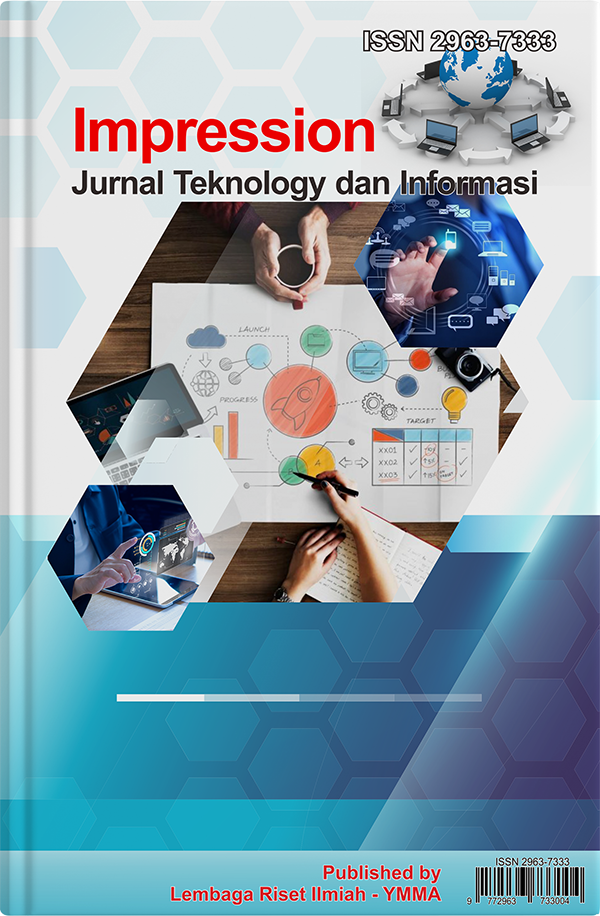Analisis Persepsi Pengguna terhadap MFA pada Aplikasi SAKTI Berdasarkan TAM
DOI:
https://doi.org/10.59086/jti.v4i3.1100Keywords:
Multi-Factor Authentication (MFA), Technology Acceptance Model (TAM), Perceived Security, PLS-SEM, SAKTIAbstract
This study analyzes user acceptance of Multi-Factor Authentication (MFA) in the SAKTI application using the Technology Acceptance Model (TAM) extended with Perceived Security (PS). PLS-SEM was employed to evaluate the measurement and structural models. A cross-sectional survey of 69 users provided the empirical basis. The results show that PS strongly influences Perceived Usefulness (PU) and Perceived Ease of Use (PEOU), with high significance (p < 0.001), while PU and PEOU positively shape attitudes toward MFA (ATT), both significant (PU: p = 0.010; PEOU: p = 0.011). In contrast, the direct relationship from PEOU to PU is not supported (p = 0.870). These findings position PS as a key external variable that enriches the application of TAM in mandatory-use settings within the public sector. User perceptions indicate that MFA is seen as enhancing account and data protection, although some still experience usage constraints such as additional time at login, device dependence, and recovery processes that are not yet seamless. To improve acceptance, security-strengthening policies should be accompanied by reductions in usage constraints and improvements in recovery experience, so that a balance between security and ease is achieved and perceived usefulness and ease foster more positive attitudes toward mandatory MFA in SAKTI.
References
Almaiah, M. A., Al-otaibi, S., Shishakly, R., Hassan, L., Lutfi, A., Alrawad, M., Qatawneh, M., & Alghanam, O. A. (2023). Investigating the Role of Perceived Risk, Perceived Security and Perceived Trust on Smart m-Banking Application Using SEM. Sustainability, 15(9908), 1–17. https://doi.org/10.3390/su15139908
Almaiah, M. A., Al-Rahmi, A., Alturise, F., Hassan, L., Lutfi, A., Alrawad, M., Alkhalaf, S., Al-Rahmi, W. M., Al-sharaieh, S., & Aldhyani, T. H. H. (2022). Investigating the Effect of Perceived Security, Perceived Trust, and Information Quality on Mobile Payment Usage through Near-Field Communication (NFC) in Saudi Arabia. Electronics (Switzerland), 11(23), 1–22. https://doi.org/10.3390/electronics11233926
Amft, S., Höltervennhoff, S., Huaman, N., Krause, A., Simko, L., Acar, Y., & Fahl, S. (2021). “We’ve Disabled MFA for You”: An Evaluation of the Security and Usability of Multi-Factor Authentication Recovery Deployments. CCS 2023 - Proceedings of the 2023 ACM SIGSAC Conference on Computer and Communications Security, 3138–3152. https://doi.org/10.1145/3576915.3623180
Andriani, R., Setyanto, A., Nasiri, A., Informatika, M. T., Korespondensi, P., Studi, K. R., & Equation, S. (2020). EVALUASI SISTEM INFORMASI MENGGUNAKAN TECHNOLOGY ACCEPTANCE MODEL DENGAN PENAMBAHAN VARIABEL EVALUATION OF INFORMATION SYSTEM USING TECHNOLOGY ACCEPTANCE. 7(3), 531–538. https://doi.org/10.25126/jtiik.20207850
Ciolino, S., Parkin, S., & Dunphy, P. (2019). Of Two Minds about Two-Factor : Understanding Everyday FIDO U2F Usability through Device Comparison and Experience Sampling This paper is included in the Proceedings of the.
Cohen, J. (1988). Statistical Power Analysis for the Behavioral Sciences.
Das, S., Wang, B., Tingle, Z., & Camp, L. J. (2019). Evaluating User Perception of Multi-Factor Authentication: A Systematic Review. http://arxiv.org/abs/1908.05901
Davis, F. D. (1989). Perceived Usefulness, Perceived Ease of Use, and User Acceptance of Information Technology. MIS Quarterly, 13(3), 319–340. https://doi.org/10.5962/bhl.title.33621
Dhagarra, D., Goswami, M., & Kumar, G. (2020). Impact of Trust and Privacy Concerns on Technology Acceptance in Healthcare: An Indian Perspective. January.
Direktorat Jenderal Perbendaharaan Kementerian Keuangan. (2024). Multi-Factor Authentication (MFA) pada SAKTI. https://djpb.kemenkeu.go.id/kppn/kotabumi/id/sakti/user-sakti/multi-factor-authentication-mfa-pada-sakti.html
Hair, J. F. (2019). When to use and how to report the results of PLS-SEM. April 2019. https://doi.org/10.1108/EBR-11-2018-0203
Hair, J. F., Hult, G. T. M., & Ringle, C. M. (2017). A primer on partial least squares structural equation modeling (PLS-SEM) (Second edi). SAGE Publications.
Hair, J. F., & Ringle, C. M. (2022). A Primer on Partial Least Squares Structural Equation Modeling (PLS-SEM). January.
Hazineh, S. A. S., Eleyan, D., & Alkhateeb, M. (2022). E-Government: Limitations And Challenges: A General Framework For To Consider In Both Developed And Developing Countries. INTERNATIONAL JOURNAL OF SCIENTIFIC & TECHNOLOGY RESEARCH, 11(01), 97–103.
Henseler, J., Ringle, C. M., & Sarstedt, M. (2015). A New Criterion for Assessing Discriminant Validity in Variance-based A new criterion for assessing discriminant validity in variance-based structural equation modeling. January. https://doi.org/10.1007/s11747-014-0403-8
Keni, K., Tjoe, H., Wilson, N., & Negara, E. S. (2020). The Effect of Perceived Security , Ease of Use and Perceived Usefulness on Intention to Use Towards Mobile Payment Services in Indonesia. 478(Ticash), 78–84.
King, W. R., & He, J. (2006). A meta-analysis of the Technology Acceptance Model A meta-analysis of the technology acceptance model. Information & Management, 43(March), 740–755. https://doi.org/10.1016/j.im.2006.05.003
Larcker, C. F. and D. F. (1981). Evaluating Structural Equation Models with Unobservable Variables and Measurement Error. Journal of Marketing Research, Vol. 18, No. 1 (Feb., 1981), Pp. 39-50, 18(1), 39–50.
Laudon, K. C., & Laudon, J. P. (2014). Manajemen Information System: Managing the Digital Firm. In New Jersey: Prentice Hall.
Legris, P., Ingham, J., & Collerette, P. (2003). Why do people use information technology ? A critical review of the technology acceptance model Why do people use information technology ? A critical review of the technology acceptance model. 7206(October 2017). https://doi.org/10.1016/S0378-7206(01)00143-4
Mushtaq, S., & Shah, M. (2025). Mitigating Cybercrimes in E-Government Services: A Systematic Review and Bibliometric Analysis. Digital, 5(1). https://doi.org/10.3390/digital5010003
Ojo, S., & Covey, A. (2025). Identity and Access Management (IAM) Authentication Methods: Importance of Multi-Factor Authentication (MFA) and Single Sign-On (SSO) and Access Control. Petsymposium.Org, 0–11. https://doi.org/10.20944/preprints202503.1830.v1
Reese, K., Smith, T., Dutson, J., Armknecht, J., Cameron, J., & Seamons, and K. (2020). A Usability Study of Five Two-Factor Authentication Methods. Proceedings of the 29th USENIX Security Symposium, 127–143.
Reynolds, J., Smith, T., Reese, K., Dickinson, L., Ruoti, S., & Seamons, K. (2018). A Tale of Two Studies : The Best and Worst of YubiKey Usability. 2018 IEEE Symposium on Security and Privacy (SP), 872–888. https://doi.org/10.1109/SP.2018.00067
Sharma, N., & Farik, M. (2016). Security Gaps In Authentication Factor Credentials. International Journal of Scientific & Technology Research, 5(11), 116–120.
Singh, C., Thakkar, R., & Warraich, J. (2023). IAM Identity Access Management—Importance in Maintaining Security Systems within Organizations. European Journal of Engineering and Technology Research, 8(4), 30–38. https://doi.org/10.24018/ejeng.2023.8.4.3074
Sugiyono. (2020). Metodologi Penelitian Kuantitatif, Kualitatif dan R & D.
Suleski, T., Ahmed, M., Yang, W., & Wang, E. (2023). A review of multi-factor authentication in the Internet of Healthcare Things. Digital Health, 9. https://doi.org/10.1177/20552076231177144
Venkatesh, V., & Davis, F. D. (2000). Theoretical extension of the Technology Acceptance Model: Four longitudinal field studies. Management Science, 46(2), 186–204. https://doi.org/10.1287/mnsc.46.2.186.11926
Zhang, Y. (2024). Impact of perceived privacy and security in the TAM model: The perceived trust as the mediated factors. International Journal of Information Management Data Insights, 4(2), 100270. https://doi.org/10.1016/j.jjimei.2024.100270
Zimmermann, V., Gerber, P., & Stöver, A. (2022). That Depends -- Assessing User Perceptions of Authentication Schemes across Contexts of Use. http://arxiv.org/abs/2209.13958
Downloads
Published
How to Cite
Issue
Section
License
Copyright (c) 2025 Grace Anne Sheila Herman, Theodorus Sendjaja

This work is licensed under a Creative Commons Attribution 4.0 International License.
Impression Jurnal Teknologi dan Informasi
Publisher Lembaga Riset Ilmiah

This work is licensed under a Creative Commons Attribution 4.0 International License.
Most read articles by the same author(s)
- Muhammad Firman, Theodorus Sendjaja, Pemanfaatan Big Data Penawaran dan Transaksi Properti untuk Prediksi Nilai Tanah dalam Praktik Penilaian , Impression : Jurnal Teknologi dan Informasi : Vol. 4 No. 3 (2025): November 2025
- Etita Alfiana Mokoginta, Theodorus Sendjaja, Adopsi Pembayaran Digital di Era Pasca-Pandemi: Telaah Literatur tentang tren, Tantangan, Implikasi Kebijakan di Indonesia , Impression : Jurnal Teknologi dan Informasi : Vol. 4 No. 3 (2025): November 2025
- I Putu Surya Sentana Putra, Theodorus Sendjaja, Pengukuran Kepuasan Pengguna Aplikasi SIMAN dengan Persepsi Nilai Sebagai Variabel Intervening , Impression : Jurnal Teknologi dan Informasi : Vol. 4 No. 3 (2025): November 2025













